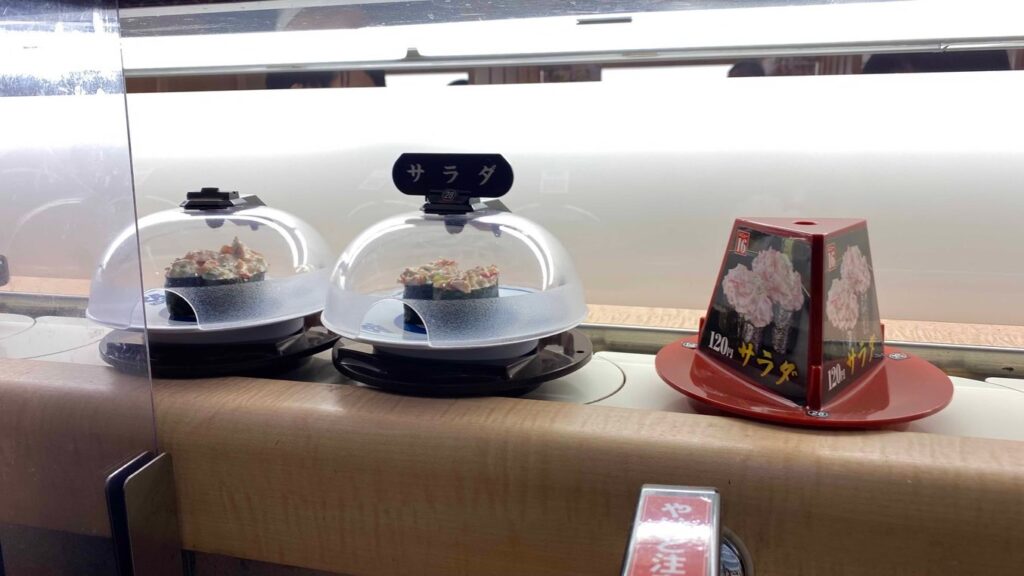
Are you planning to visit Japan and want to try conveyor belt sushi? In addition to being very affordable, it’s certainly an interesting experience. At first, it might seem a bit complicated because in many such restaurants, no staff will greet you—everything is automated using tablets. However, it’s actually quite simple. So, how does it work?
Note: Prices are based on the year 2023.
What is conveyor belt sushi?
Known in English as ‘running sushi’ or in Japanese as ‘kaiten sushi’ or ‘kaitenzushi’ (depending on pronunciation). As the name suggests, it’s sushi that is not brought to you by a server but ‘travels’ to you on a moving conveyor belt, from which you take it yourself. In fact, today, almost all of these restaurants are set up so that from your arrival, seating at the table, to paying, you handle everything on your own.
How much does this type of sushi cost?
This kind of sushi is known for being inexpensive. Prices generally range from 120 yen (about €0.71) per plate, with most plates containing two pieces. So, one piece costs around 35 cents. That sounds almost unbelievable, right?
Of course, the quality won’t be top-tier, like in a sushi restaurant where a sushi master serves each piece in front of you, or where everything is perfectly styled. But for the price, it’s still a very decent level. And most importantly, you’re ‘at the source.’ Fish dishes and fresh fish in general are a staple in Japan, and it’s obviously much easier to access fresh fish there.
Which kaitenzushi restaurants should you visit in Japan?
Conveyor belt sushi is very popular among locals as well. It’s cheap, fast, and convenient—unless it’s during lunchtime, when these restaurants can get really crowded. There are several types of these restaurants in Japan. One of the most well-known is the Kura Sushi chain, which offers a good price-to-quality ratio with relatively large sushi pieces at affordable prices. Other popular ones include:
- Sushiro
- Hamazushi
- Toriton
- Kappa Sushi
- Uobei Sushi
- Genki Sushi
But the list doesn’t end here. There are many more of these types of sushi restaurants throughout Japan.
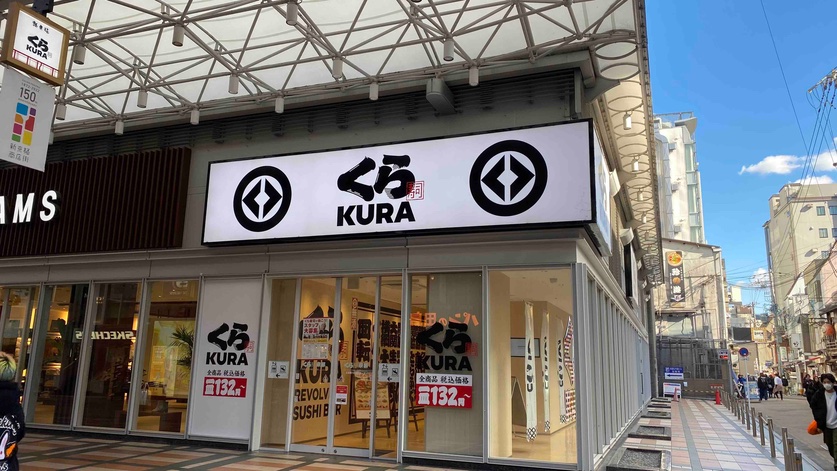
How does a conveyor belt sushi restaurant work, and how do you order?
Let’s look at an example of Kura Sushi, which has over 400 locations across Japan. Each restaurant might have its system set up a little differently. In some places, there’s even an open kitchen style, where you sit at a counter around sushi chefs and can watch them prepare each piece before placing it on the moving belt. However, this is more typical of smaller establishments. Larger chains, like Kura Sushi, usually operate similarly, and you typically don’t see the sushi chefs.
1. Arrival – How to choose your seating?
The entire process is designed so you don’t need help from staff. However, if it’s your first time and you feel lost, you can simply ask the staff for assistance—they’re used to helping newcomers.

When you enter, you’ll likely see a tablet right at the entrance. I’ve noticed that most of them don’t offer an English language option. You’ll press the blue button, then enter the number of people (adults first, then children), and choose whether you want to sit at a table or at the counter (the counter is meant for solo diners). Japan is very solo-traveler-friendly in this regard.
The tablet will give you a ticket, and two scenarios can happen:
- If it’s not crowded, it will immediately assign you a table number, and you can go sit down (keep the ticket with the number).
- If it’s full, it will give you a waiting number. A large screen will display these numbers being called in order. When your number appears, go back to the tablet, press the red button, and it will give you a table number. You can then go sit down (again, keep the ticket).
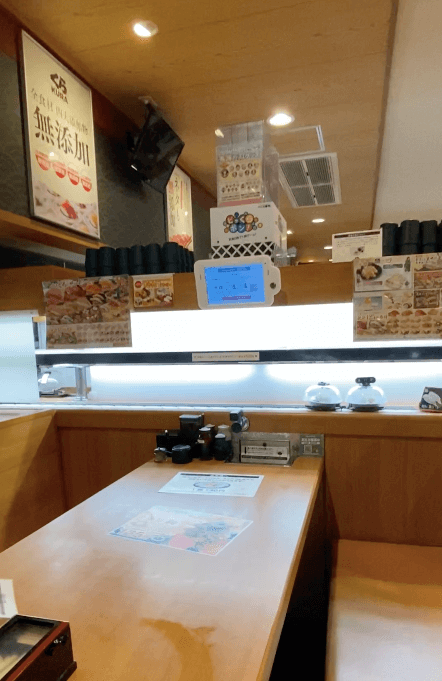
2. At the table – How to order?
On the table, you’ll find everything you need for your meal. You can order drinks, but if you’re okay with it, there will be a container of powdered Japanese green tea on the table, which you can mix yourself. This tea is included in the price.
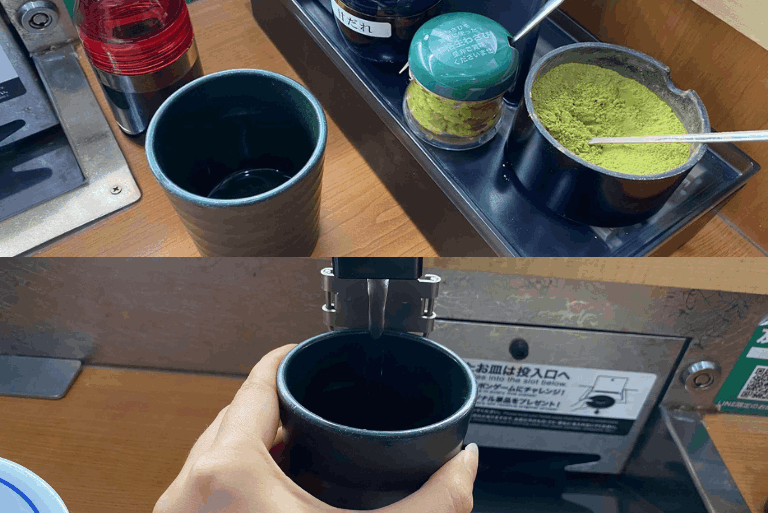
And you can begin. There will be two conveyor belts. The top belt is used to deliver food you order via the tablet. On the lower belt, sushi moves by in random order. You can see the price for each type of sushi. Don’t take the entire plastic container with the lid—just lift the plate gently by the edge, and the lid will open automatically. Once you’re done with a plate, drop it into the slot at the end of the table. For every five plates, you can play a game on the tablet, which is like a random roulette. If you’re lucky, you might win a small prize (usually a toy).
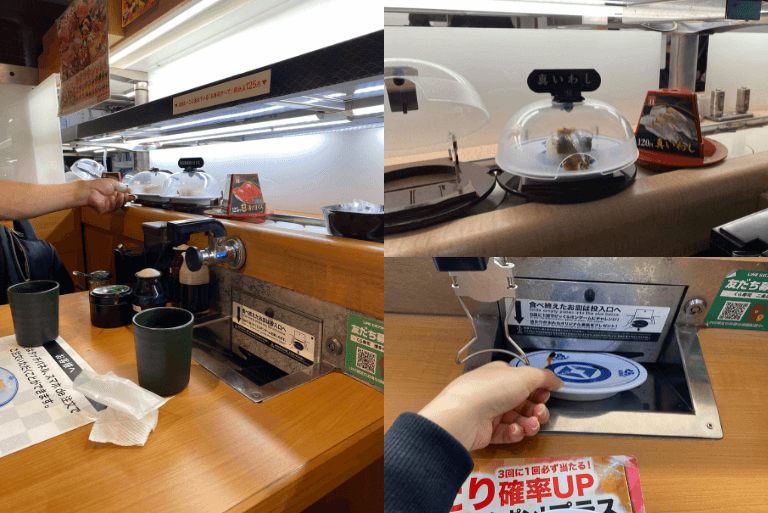
If it seems like your favorite sushi isn’t coming around, you can order specific pieces using the tablet. The menu here is available in English. Besides sushi, you can also choose from soups like miso soup, udon, or even a small ramen. You can also order various drinks and even some desserts. The tablet will also show you an approximate wait time for your order.
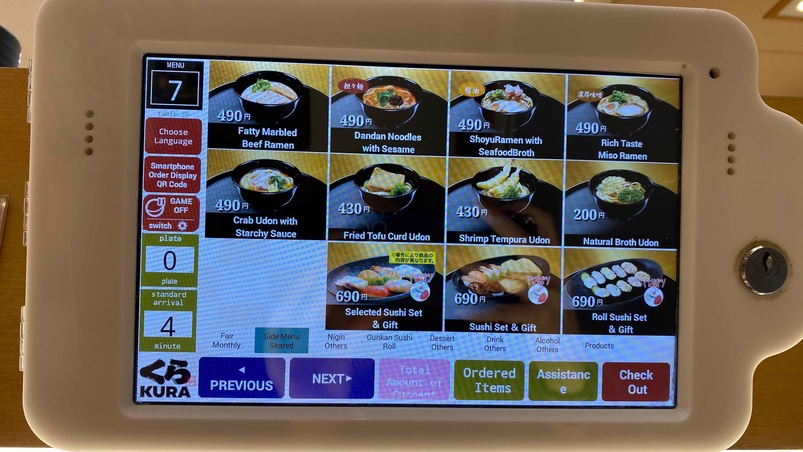
3. How to ask for the bill and pay?
On the tablet, select the ‘check-out‘ option. Then, take the ticket you received at the beginning and go to the self-service kiosk. Scan the ticket, choose your payment method, and complete the payment.
Etiquette in a conveyor belt sushi restaurant
At the turn of 2022/2023, there was an unfortunate incident where Japanese teenagers licked and touched cups, sauce bottles, and even food on the conveyor belt in these restaurants. It became quite a national scandal, even covered by global media. It was somewhat surprising that it was Japanese people doing this (well, fools can be found everywhere), and they filmed it and shared it on TikTok, making it not too difficult to track them down in the end.
Anyway, certain unwritten rules apply in such restaurants, such as:
- If you touch a plate on the conveyor belt, you should take it, even if you didn’t actually touch the sushi.
- Don’t take more plates than you can eat.
- Don’t put anything else into the slot where plates are returned.
- Don’t place empty plates or anything else on the conveyor belt.
- Don’t take items from the upper belt that someone has likely ordered.
Interested to discover more about Japanese cooking and culture? Let’s keep in touch on Instagram, Facebook, and Pinterest.
Sharing is caring: